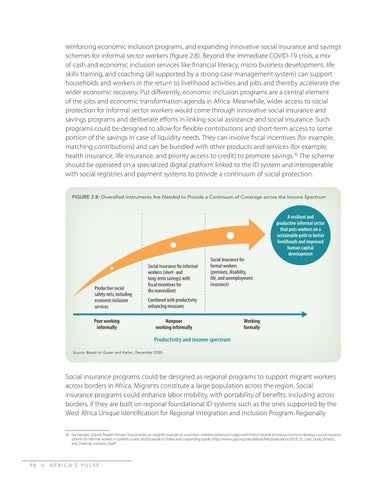reinforcing economic inclusion programs, and expanding innovative social insurance and savings schemes for informal sector workers (figure 2.8). Beyond the immediate COVID-19 crisis, a mix of cash and economic inclusion services like financial literacy, micro business development, life skills training, and coaching (all supported by a strong case management system) can support households and workers in the return to livelihood activities and jobs and thereby accelerate the wider economic recovery. Put differently, economic inclusion programs are a central element of the jobs and economic transformation agenda in Africa. Meanwhile, wider access to social protection for informal sector workers would come through innovative social insurance and savings programs and deliberate efforts in linking social assistance and social insurance. Such programs could be designed to allow for flexible contributions and short-term access to some portion of the savings in case of liquidity needs. They can involve fiscal incentives (for example, matching contributions) and can be bundled with other products and services (for example, health insurance, life insurance, and priority access to credit) to promote savings.30 The scheme should be operated on a specialized digital platform linked to the ID system and interoperable with social registries and payment systems to provide a continuum of social protection. FIGURE 2.8: Diversified Instruments Are Needed to Provide a Continuum of Coverage across the Income Spectrum
Productive social safety nets, including economic inclusion services Poor working informally
Social insurance for informal workers (short- and long-term savings) with fiscal incentives for the nonresilient
Social insurance for formal workers (pensions, disability, life, and unemployment insurance)
A resilient and productive informal sector that puts workers on a sustainable path to better livelihoods and improved human capital development
Combined with productivity enhancing measures Nonpoor working informally
Working formally
Productivity and income spectrum Source: Based on Guven and Karlen, December 2020.
Social insurance programs could be designed as regional programs to support migrant workers across borders in Africa. Migrants constitute a large population across the region. Social insurance programs could enhance labor mobility, with portability of benefits, including across borders, if they are built on regional foundational ID systems such as the ones supported by the West Africa Unique Identification for Regional Integration and Inclusion Program. Regionally 30 For example, Ghana’s People’s Pension Trust provides an insightful example of a tool that combines behavioral nudges with fintech (mobile phones/accounts) to develop a social insurance scheme for informal workers. It currently covers 50,000 people in Ghana and is expanding rapidly. https://www.cgap.org/sites/default/files/publications/2019_05_Case_Study_Fintech_ and_Financial_Inclusion_0.pdf.
98
>
A F R I C A’ S P U L S E

